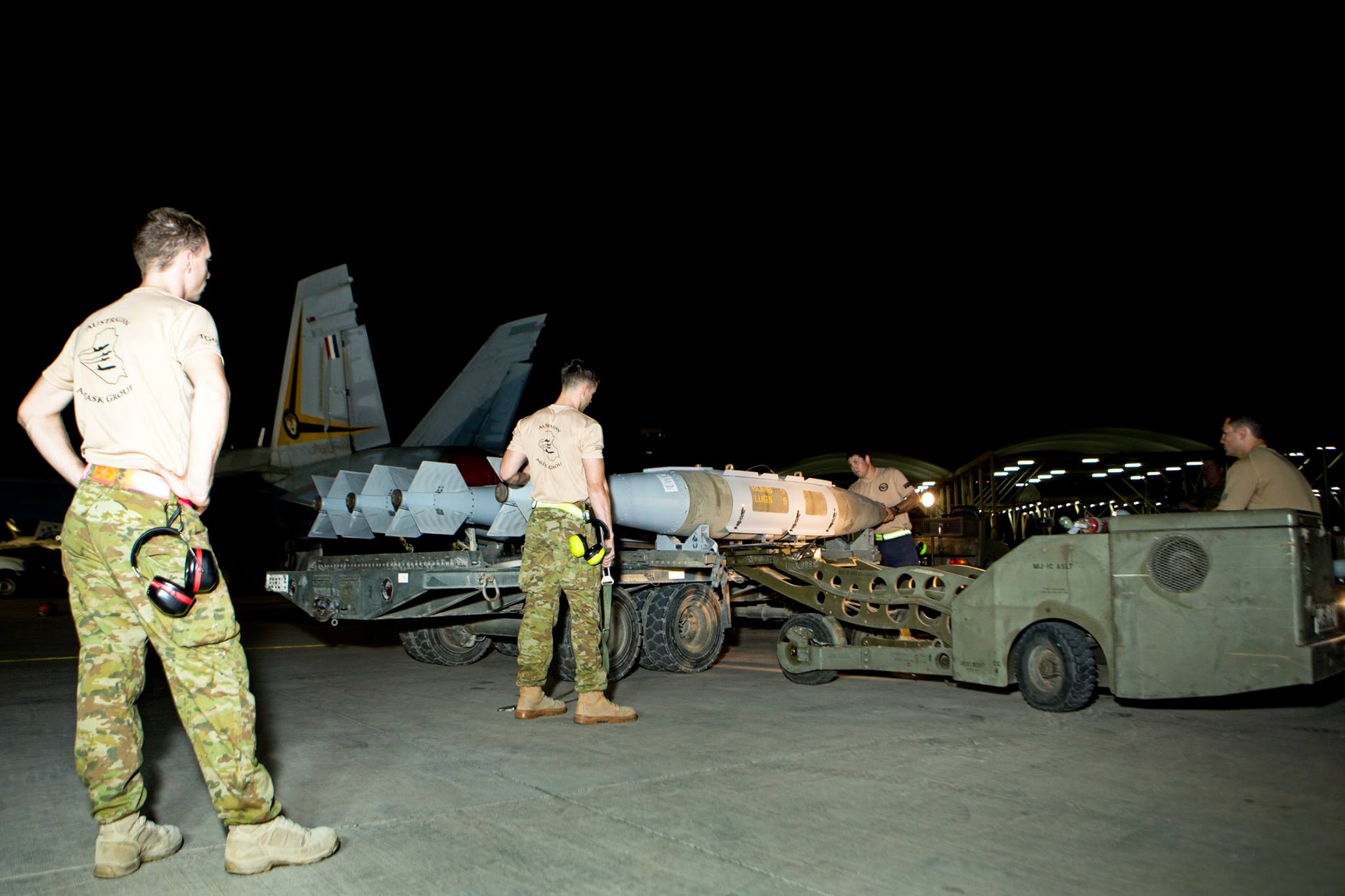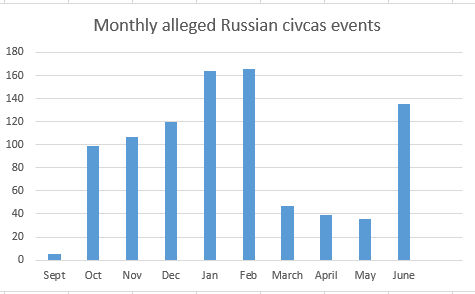Daesh lost significant ground in June, with the liberation of Fallujah in Iraq and the ongoing battle for Manbij in Syria. However, this led to a steep rise in alleged civilian casualties involving the Coalition in both countries – while in Syria, we saw a quadrupling of the number of civilian casualty events reportedly involving Russian aircraft.
Coalition military developments
Overall, a total of 9,132 airstrikes had been carried out in Iraq and 4,398 in Syria to the end of June 2016.
The 13 allies had between them cumulatively dropped 49,917 bombs and missiles against Daesh, with a 35 per cent rise in the number of munitions released compared with May.
Denmark restarted its air campaign, with the first strikes reported in Iraq on June 24th. Following a vote by parliament, Danish F-16’s will now also be carrying out airstrikes in Syria
On June 27th, Belgium reported it had taken over airstrikes from the Dutch, deploying six of its own F-16s to the Middle East. The Dutch had fought continually for 21-months and were the fourth most active partner in the Coalition after the US, the UK and France – despite their relatively small force.
To June 28th, Britain’s MoD had reported 847 airstrikes in Iraq but only 48 in Syria. An analysis of official UK data by Drone Wars UK revealed:
- A huge increase of 85% in British airstrikes in Iraq and Syria was recorded between July and Dec 2015 (249 strikes) and January to June 2016 (464 strikes).
- There has been a significant increase in the use of British armed drones since April. June saw the greatest number of Reaper airstrikes in any one month since the RAF began fielding them in October 2007.
- The UK has used much larger weapons in recent months. On June 26th, the RAF airdropped Stormshadow cruise missiles for the first time against Daesh in Iraq. There has also been increased use of both the 1,000 lb Enhanced Paveway II and 2,000 lb Paveway III bombs.
UK Tornados used huge Stormshadow missiles for the first time against Daesh on June 26th, striking a large concrete bunker being used as a weapons facility in western Iraq.
Coalition actions in Iraq and Syria for June 2016
There were 482 Coalition airstrikes in Iraq in June – a small decrease (4%) from the 504 airstrikes carried out in May.
On June 26th it was announced that the city of Fallujah, which had fallen to Daesh in January 2014, had been liberated. Two days later Iraqi forces retook remaining pockets of Daesh resistance in the city’s western outskirts.
However, the United Nations warned of a potential humanitarian disaster, with up 30,000 civilians fleeing the city.
June saw the greatest number of Coalition actions yet reported in Syria during the 23-month war, with 375 airstrikes declared. This was an increase of 110% from May (178 strikes).
68% of these strikes were near Manbij, where a major offensive to retake the city began on May 21st by US proxies the Syrian Arab Coalition (or Syrian Democratic Forces), supported by Coalition airstrikes.
On June 30th, the Coalition reported it had carried out 44 airstrikes alone that week around Manbij, and that the Syrian Arab Coalition had gained a crucial foothold in the southern part of the city – though Daesh continued to use snipers, tunnels, booby traps and human shields, while maintaining control of vital grain silos and administrative buildings.
But in Deir Ezzor, there were set backs with the Syrian Observatory for Human Rights reporting on June 29th that the New Syria Army had been driven out of the governorate and had failed to recapture the key Iraqi border town of Al-Bukamal.
Coalition civilian casualties
In both Iraq and Syria, there was a steep rise in casualty events allegedly involving Coalition aircraft in June. Overall, there were 34 alleged civilian casualty incidents – an increase of 79% from May, when 19 were reported. A total of 229 to 335 non-combatant deaths were claimed.
Airwars presently assesses 16 of these 34 events as fairly reported: that is with two or more credible sources, and Coalition strikes confirmed in the near vicinity. Between 110 and 180 civilians are presently assessed as likely having been killed in these incidents, compared with between 84 and 93 deaths in May.
Coalition incidents of concern: Syria
The greatest rise in alleged casualty events was seen in Syria, where 19 incidents were reported – an increase of 72% from the 11 claimsed events tracked in May.
June 2016 saw the highest number of alleged civilian deaths to date from Coalition actions in Syria. Between 58 and 75 alleged fatalities are presently assessed as being likely by Airwars, compared with between 38 and 41 deaths in May.
Of the 19 claimed incidents in Syria, 15 (78%) were around Manbij. We have graded nine of these as fairly reported, and estimate that between 48 and 64 civilians were killed in these incidents.
Major casualty incidents of concern attributed to Coalition aircraft around Manbij included:
On June 3rd, local groups named 22 victims including 13 to 15 children and six women killed in a ‘Coalition strike’ on the village of Ojkana, near Manbij. Both the Shaam News Network and the Syrian Press Center attributed the deaths to the US-led Coalition, while the Syrian Revolution Network named multiple victims across three families
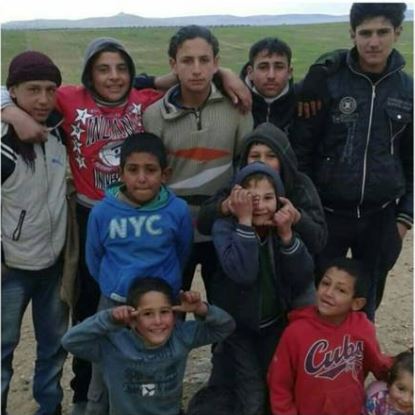
Reported child victims of a Coalition strike near Manbij June 3 2016 (via Manbij Mother of All the World)
On June 11th, ten civilians from the same family were reported killed in an alleged Coalition strike on the village of Al Hadhad, near Manbij, as fierce fighting continued to evict so-called Islamic State forces from the area. The dead family was named by Manbij Mother of All the World as that of Mahmoud al Ahmad al Khattaf.
ريف حلب #منبج
استشهاد 10 اشخاص من عائلة واحد نتيجة قصف طيران التحالف الدولي قرية الهدهد
جميع الضحايا نازحين من قرية الخطاف— Syrian Revolution Network شبكة الثورة السورية (@RevolutionSyria) June 11, 2016
A Tweet from Syrian Revolution reports the death of 10 people from the same family in Manbij on June 11th
On June 13th, a reported Coalition airstrike on the agricultural secondary school in Manbij – being used as a temporary prison by so called Islamic State – led to the deaths of between 8 and 20 civilian captives according to local reports. Al Araby al Jadid placed the death toll much higher at 30, with 50 injured – though this included Daesh fighters.
Coalition incidents of concern: Iraq
There was also a significant increase in incidents of concern in Iraq, where 15 events were reported, an 87% rise from the eight cases we tracked in May.
Between 52 and 104 civilian fatalities in Iraq are presently assessed as likely by Airwars in June 2016, compared with between 46 and 52 likely deaths in May.
Major incidents of concern were reported around Mosul and Fallujah:
On June 1st, ten to 40 civilians were reported killed and 13 to 36 injured following alleged Coalition airstrikes in west Mosul. Mosul Eye offered a detailed description of affected neighbourhoods, while NRN said that Coalition aircraft targeted houses used by Daesh, killing terrorists but also civilians.
On June 8th, multiple civilians were reported killed and injured in alleged Coalition airstrikes on the July 17th district of Mosul. According to Mosul Eye, the strikes on a Wednesday night took place at prayer time near a mosque in the Almoghait area – particularly busy during Ramadan. There was a possibility of British involvement, with the UK reporting that “In northern Iraq, another Typhoon mission successfully attacked a Daesh-held building east of Mosul, whilst a Reaper used a GBU-12 bomb to demolish a building where another coalition surveillance aircraft had observed terrorists unloading supplies.”
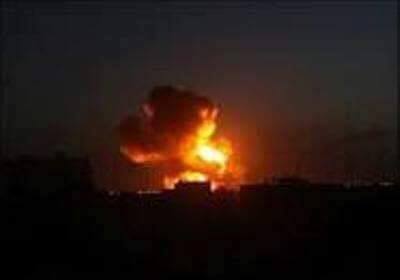
Reported Coalition strike on Mosul June 8th which allegedly caused ‘dozens’ of civilian casualties (via Iraqi Revolution)
And on June 15th, local sources reported that the Coalition struck the Hasi area of Fallujah, leading to the death of six families, two of whom were killed while trying to leave the city. Al Fallujah Online said 10 people died, including four women and three children, and that 13 others were wounded including five children and four women. Again there was the possibility of UK involvement in the reported event, with the MoD reporting that Typhoons carried out “successful attacks” over Fallujah.
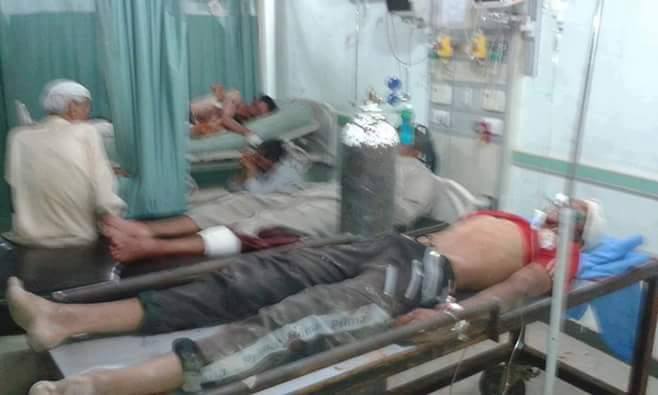
Casualties in a medical facility following alleged Coalition strikes on Fallujah, June 15th (via Al FallujahNews)
Still unclear is how many civilians may have died in two massive Coalition and Iraq government air assaults on Daesh convoys escaping Fallujah on June 28th and June 30th. Many vehicles were destroyed, with the Coalition estimating that its own aircraft killed at least 348 enemy fighters. But there are credible reports the convoys also included the families of Daesh fighters. As USA Today reported of the second incident “About 50 people, including women and children, fled the vehicles. When the women and children were spotted, the coalition ceased its strikes.” At least one dead child was spotted by Bellingcat in an Iraqi government propaganda video relating to the strikes.
Russian military actions and civilian casualties
Following the Syrian cease fire and Russia’s announcement of a partial drawdown on March 15th, we saw an immediate 75% reduction in allegations of civilian casualty events involving Russia in Syria, and by April we were recording similar numbers of allegations against Russia and the Coalition (in Iraq and Syria).
However that trend reversed in late May, with reported Russian strikes and civilian casualty claims once more escalating. We tracked 36 incidents in May and 135 in June – a fourfold rise.
Due to the volume of alleged Russian incidents, Airwars is still in the process of assessing events from January to the end of June.
Raw estimates claim that between 595 and 648 civilians died in these June events, while 153 to 191 people were claimed killed in May – though it will be some time before Airwars is better able to assess these allegations.
This increased Russian involvement in Syria means it is often challenging to determine which parties were responsible for attacks – with contested reports sometimes blaming Russia, the Assad regime and the Coalition.
Additional research by Kinda Haddad, Latif Habib, Basile Simon, Christiaan Triebert and Chris Woods


